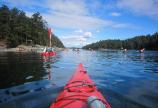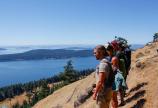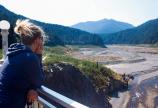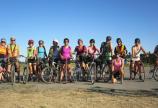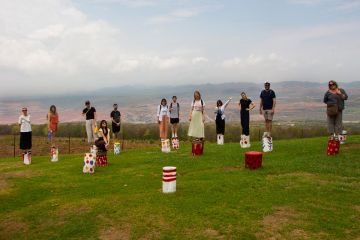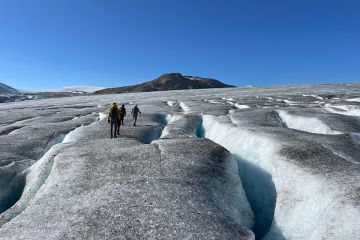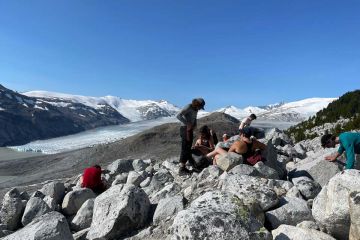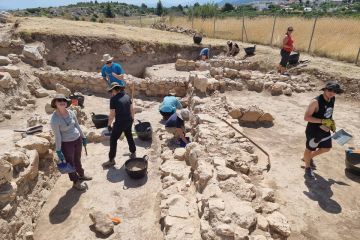Studying sea, learning land and leadership
- Anne MacLaurin
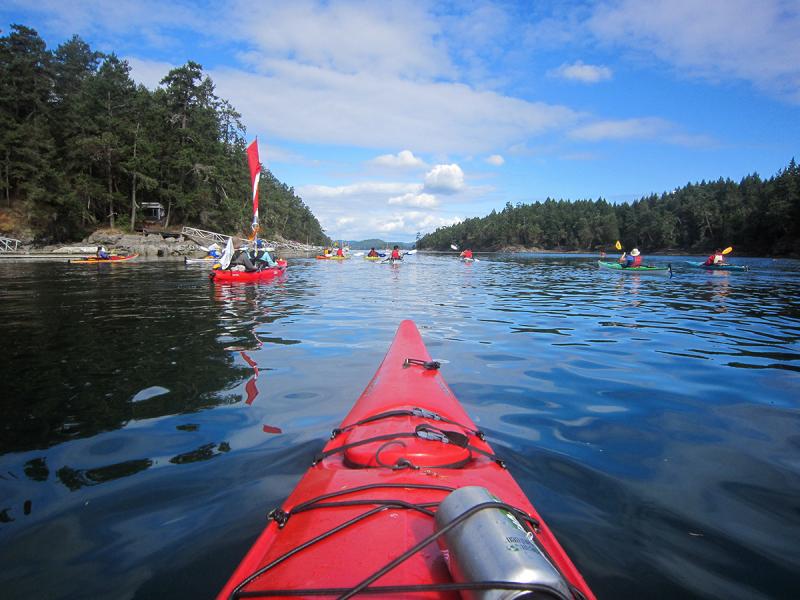
Redfish teaches you about the systems of non-human and human nature around you, and shows you a community that you are a part of and you can help change.
—Niloo Farahzadeh, 2015 Redfish alumna
The Salish Sea is a vibrant international region, teeming with change—so it should come as no surprise that an international field school which puts dynamic learning experiences at the heart of sustainability leadership reflects those characteristics as well.
For six weeks last summer, 13 students, two program assistants, and three instructors with the Redfish School of Change traveled by kayak, bicycle, ferry and foot, exploring and serving communities on both sides of the international border in the Salish Sea. The UVic School of Environmental Studies and GreenLearning Canada have partnered since 2008 to offer this three-course summer field school in various locations in BC. In 2015, for the first time, the group included students from Western Washington University (WWU) in Bellingham, Washington, and focused exclusively on this region. Ryan Hilperts, who directs the field school, wanted to go beyond borders and since the waters of the Salish Sea are shared between Canada and the United States, it made perfect sense.
“Redfish is really about helping students find their place in movements for positive change, and building a shared sense of place among future change-makers. I wanted to help cultivate a network in the Salish Sea, so I reached out to David Rossiter at the Centre for Canadian-American Studies at WWU and UVic alumnus and WWU professor Nick Stanger, who agreed to co-teach the course with myself and Brenda Beckwith, who has been with the program since the beginning,” says Hilperts. “Nick was a perfect fit because of his research into human connections to place,” adds Hilperts.
Stanger saw the match, too. “I finished my PhD in UVic’s Faculty of Education, where I focused on how people learn from transformative places over the course of their lives,” he explains. “I was immediately intrigued, since I had completed my masters in the same program as Nadine Reynolds, the founder of Redfish,” adds Stanger.
“Redfish is ‘learning-by-doing’—a unique combo plate of skill building, knowledge integration and personal growth,” says Beckwith. “As students learn content they reflect on their role as learners—not just as students—figuring out for themselves how best they can adopt and enhance their roles as community leaders. It is an privilege to help facilitate this tremendous awakening within them,” she adds.
The Redfish courses are: “Community Based Education for Sustainability” (Stanger), “Ethnoecology of the Salish Sea” (Beckwith), and “Leadership Skills for Community Action” (Hilperts).
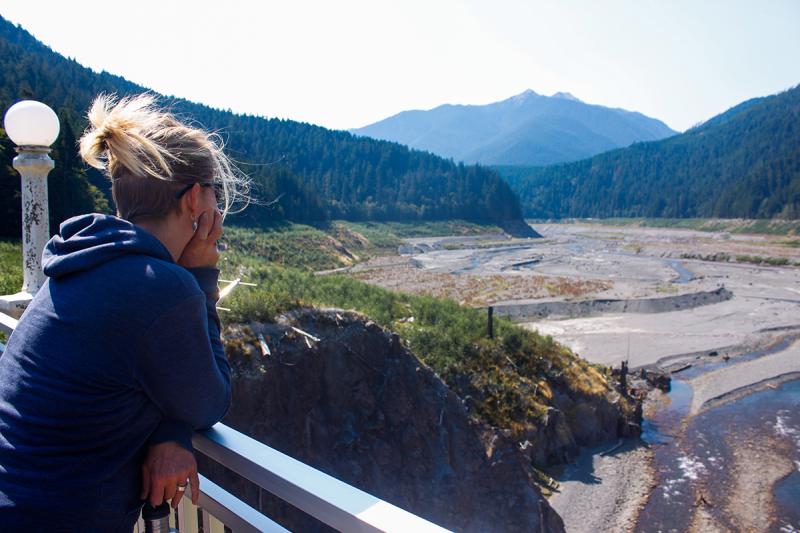
Student paths and projects
Each student enters the program with a proposed Community Action Project (CAP) that they develop during the course of the unique field experience, and then work to implement after the program is over.
Acy Wood, 2015 Redfish alum, says he applied to the program on a whim and it was an excellent learning experience. “I saw the ad for Redfish on a napkin dispenser in the dining hall of Western Washington University—I applied immediately,” says Wood.
According to Wood, the program changed the way he thought about local food systems and community. For his CAP, Wood became an activist for a remote First Nations camp that was opposed to the building of the Enbridge pipeline and the Pacific Trials Pipeline. The camp is known as Unist'ot'en (People of the Headwater). The camp is held on Wet'suwet'en First Nation territory on the Bulkley River in the BC interior.
“My project was to spread word about the camp and to spark conversation about the encroachment of outside governments onto the sovereign land of the First Nations of the British Columbia Salish Sea,” says Wood.
“Most people I encounter don't know much about the coal train projects or the pipelines and frankly just don't care. The first step is to establish a dialogue to try to at least get the idea in their minds. If they at least talk about it with others, then I've been successful,” continues Wood.
He is now finding future work in land stewardship, what it means, and how to ensure community and land are all maintained while bringing people together.
For another Redfish participant, UVic English major Niloo Farahzadeh, the program taught her how to engage with social and environmental issues while engaging with her community through volunteering for groups.
“I learned how to build towards change, but I also learned that there are many roles to take on in changing a community for the better and that all positions in this movement towards change are valuable,” says Farahzadeh.
“Through Redfish we got to meet a network of change-makers in our community, we got to talk to them and listen to their advice,” adds Farahzadeh.
“Basically, Redfish is what education should look like if our society wants to create students that are motivated to improve life for all humans and non-human nature,” says Farahzadeh.
Farahzadeh’s CAP incorporates environmental and social activism into her music and songwriting. Performing her songs at events and fundraisers has helped to support the issues that mattered most to her.
And for Shannon Purington, an art student at Western Washington University and a 2015 Redfish alumna, art emerged as a platform for social change.
Purington designed her CAP in two phases: first volunteering with MakeShift, an artist run studio in Bellingham, and then organizing and hosting a show of environmental artists.
“With the experiences of the past few months under my belt and with the overwhelming encouraging of my fellow Redfishies, I will make the conscious effort to adopt the term artist as one that applies to me,” says Purington.
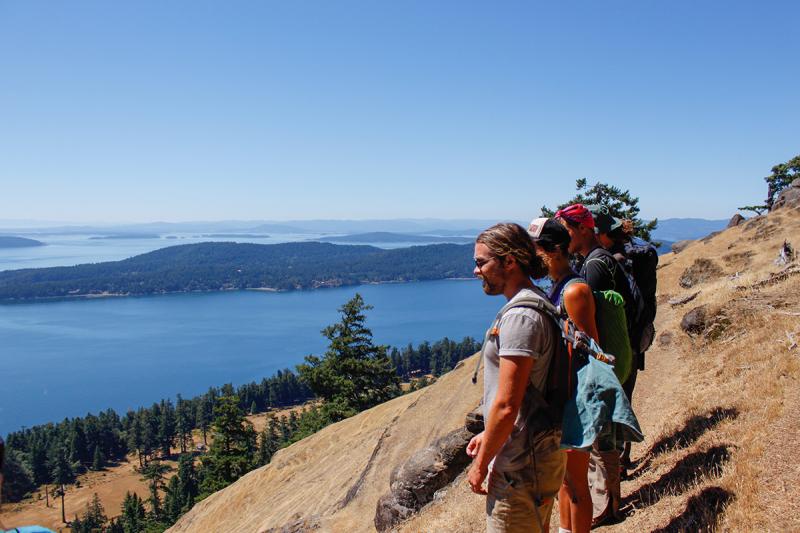
Mapping stories online
“Another central learning piece of the program is the Story Map Journal.” says Hilperts, “Students interview community members and discuss what they are learning in an interactive online format that allows them to share the stories with maps and locations.”
Combining the story map with the hands-on learning and intensive community living, students gain knowledge, skills, and confidence to lead a meaningful community action project in their own communities after the field school. The students receive support from Redfish mentors in the months following the field school to implement their project.
For UVic Environmental Studies major Taylor Howson it was discovering a passion for salmon conservation that sparked his community action project.
“During the Redfish program I had the opportunity to work with a few of my fellow students in putting together a restoration plan for a degraded stream on Pender Island. This assignment sparked an interest in salmon, and I decided to focus my CAP project on salmon. I wrote an article on how climate change is impacting salmon populations in the Pacific Northwest and how different groups are using habitat restoration to preserve existing salmon-bearing streams. I shared the article on different social media sites.”
Howson adds that, “it was through the hands-on experiences of Redfish that I found a subject that I am passionate about.”
Hilperts , Stanger, and Beckwith are pleased the borders of the program are expanding again - this year’s Redfish School of Change runs from June 26 to Aug. 6, 2016—with students from Northwest Indian College, Western Washington University, University of Utah and UVic.
“This mixture is part of how the magic works,” says Stanger, “facilitating the weaving of the complexity of worldviews, background knowledge, and passions creates a dynamic matrix for teaching and learning.”
“As a community we embody what we learn, creating the spaces for the students to reach for their potential. Many of the learning experiences that allow for magic to emerge cannot be taught per se. That is the magic of Redfish,” adds Beckwith.
Students receive credit for three environmental studies courses from UVic or WWU (transfer credits available), and six months support on their environmental and social justice action projects. Undergraduate students from all disciplines are eligible and encouraged to consider this program as a complement to their studies.
Visit: Redfish School of Change
Photos
In this story
Keywords: field schools, student life, environmental studies, sustainability, community

